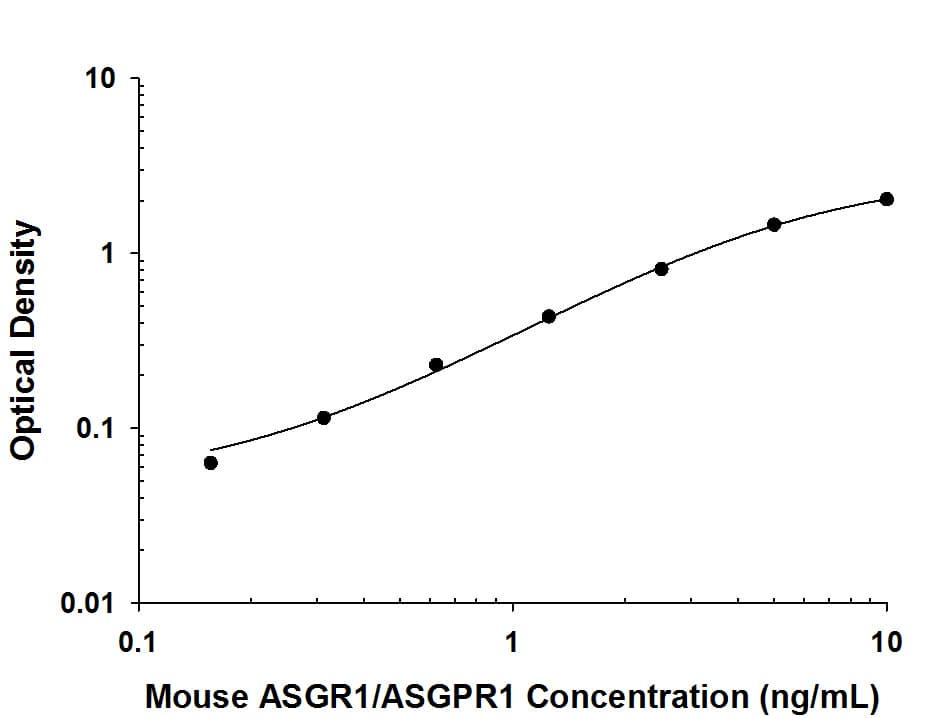Mouse ASGR1/ASGPR1 Antibody
R&D Systems, part of Bio-Techne | Catalog # MAB27551

Key Product Details
Species Reactivity
Applications
Label
Antibody Source
Product Specifications
Immunogen
Ser60-Asn284
Accession # NP_033844
Specificity
Clonality
Host
Isotype
Scientific Data Images for Mouse ASGR1/ASGPR1 Antibody
Mouse ASGR1/ASGPR1 ELISA Standard Curve.
Recombinant Mouse ASGR1/ASGPR1 protein was serially diluted 2-fold and captured by Rat Anti-Mouse ASGR1/ASGPR1 Monoclonal Antibody (Catalog # MAB27551) coated on a Clear Polystyrene Microplate (Catalog # DY990). Rat Anti-Mouse ASGR1/ASGPR1 Monoclonal Antibody (Catalog # MAB27552) was biotinylated and incubated with the protein captured on the plate. Detection of the standard curve was achieved by incubating Streptavidin-HRP (Catalog # DY998) followed by Substrate Solution (Catalog # DY999) and stopping the enzymatic reaction with Stop Solution (Catalog # DY994).Applications for Mouse ASGR1/ASGPR1 Antibody
ELISA
This antibody functions as an ELISA capture antibody when paired with Rat Anti-Mouse ASGR1/ASGPR1 Monoclonal Antibody (Catalog # MAB27552).
This product is intended for assay development on various assay platforms requiring antibody pairs.
Formulation, Preparation, and Storage
Purification
Reconstitution
Formulation
Shipping
Stability & Storage
- 12 months from date of receipt, -20 to -70 °C as supplied.
- 1 month, 2 to 8 °C under sterile conditions after reconstitution.
- 6 months, -20 to -70 °C under sterile conditions after reconstitution.
Background: ASGR1/ASGPR1
The mouse asialoglycoprotein receptor (ASGP-R) is an endocytic recycling receptor that belongs to the long-form subfamily of the C-type/Ca++-dependent lectin family (1‑3). It is a complex of two non‑covalently linked subunits, a major 42 kDa glycoprotein (ASGPR1), and a minor 51 kDa glycoprotein (ASGR2). The major mouse ASGP‑R subunit, ASGPR1, is synthesized as a 284 amino acid (aa) type II transmembrane (TM) protein that contains a 39 aa cytoplasmic region, a 21 aa TM segment, and a 224 aa extracellular domain (ECD) (4-6). The ECD contains two important structural regions. The first is a stalk region of 56 aa (aa’s 59-117) that contributes to non-covalent oligomerization. The second is a 118 aa, carbohydrate-binding, Ca++-dependent C-type lectin domain (aa’s 160-277) that is unusually stabilized by three Ca++ ions (3, 5). There are two potential alternate splice forms for ASGPR1. Both are TM and show a deletion of the C-type lectin domain. One is 113 aa in length and shows a deletion of aa’s 114-284 (7). The second is 132 aa in length and shows a deletion of aa’s 118-146 and aa’s 162-284 (8). Mouse ASGPR1 ECD is 89% and 79% aa identical to the ASGPR1 ECD in rat and human, respectively. The minor mouse ASGP-R subunit, ASGR2, is also a C-type lectin that shares the same structural organization as ASGR-1. It is 301 aa in length and has two 45 kDa and 51 kDa differentially-glycosylated isoforms (4, 6, 9). The ECD of ASGR2 is 50% aa identical to the ECD of ASGPR1. Although ASGPR1 and 2 can be expressed individually, a fully functional and stable ASGP-R requires simultaneous expression of both subunits (10-12). The stoichiometry of a functional ASGP-R is suggested to be either a 2:2, 3:1 or 3:2 ratio of ASGPR1:ASGR2 (13, 14). ASGPR1 is reported to bind Gal (nonreducing), GalNAc, and sialic acid alpha2,6GalNAc (3, 15, 16). This is generally in the context of triantennary or tetraantennary configurations (2).
References
- Stockert, R. J. (1995) Physiol. Rev. 75:591.
- Weigel, P.H. and J.H.N. Yik (2002) Biochim. Biophys. Acta 1572:341.
- Meier, M. et al. (2000) J. Mol. Biol. 300:857.
- Takezawa, R. et al. (1993) Biochim. Biophys. Acta 1172 :220.
- Monroe, R.S. and B.E. Huber (1994) Gene 148:237.
- Sanford, J.P. et al. (1988) DNA 7:721.
- Heath, P. (2005) GenBank Accession #:Q5NCV2
- Heath, P. (2005) GenBank Accession #:Q5NCV1.
- Sanford, J.P. and D. Doyle (1990) Biochim. Biophys. Acta 1087:259.
- Braun, J.R. et al. (1996) J. Biol. Chem. 271:21160.
- Ishibashi, S. et al. (1994) J. Biol. Chem. 269:27803.
- Tozawa, R. et al. (2001) J. Biol. Chem. 276:12624.
- Bider, M.D. et al. (1996) J. Biol. Chem. 271:31996.
- Lodish, H. (1991) Trends Biochem. Sci. 16:374.
- Westerlind, U. et al. (2004) Glyconj. J. 21:227.
- Park, E.I. et al. (2005) Proc. Natl. Acad. Sci. USA 102:17125.
Long Name
Alternate Names
Gene Symbol
UniProt
Additional ASGR1/ASGPR1 Products
Product Documents for Mouse ASGR1/ASGPR1 Antibody
Product Specific Notices for Mouse ASGR1/ASGPR1 Antibody
For research use only
